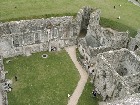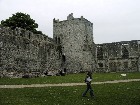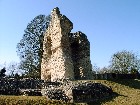A common misconception today is that the Normans were "French." Strictly speaking this is not true although it is a widely held belief and, like most beliefs, has some basis in fact.
 Towards the end of the ninth century, the Viking raiders from Northern Europe (commonly known as Norsemen) were regularly foraging (raiding and trading) along the coast line of the Frankish kingdoms. During these raids, the Vikings got more and more bold - even going as far as sailing up the Seine and sacking Paris. Initially the raiders would set off from their home villages in Scandinavia and return a few weeks later with any plunder they had gathered, however as the raids continued the Norsemen started establishing raiding bases away from home. It was during this time that England was invaded by the "Grand Army" (more detail in the Vikings Section). These bases were often in very good farmland and quickly grew rich with the spoils of war, and as a result of this quickly grew in size.
Towards the end of the ninth century, the Viking raiders from Northern Europe (commonly known as Norsemen) were regularly foraging (raiding and trading) along the coast line of the Frankish kingdoms. During these raids, the Vikings got more and more bold - even going as far as sailing up the Seine and sacking Paris. Initially the raiders would set off from their home villages in Scandinavia and return a few weeks later with any plunder they had gathered, however as the raids continued the Norsemen started establishing raiding bases away from home. It was during this time that England was invaded by the "Grand Army" (more detail in the Vikings Section). These bases were often in very good farmland and quickly grew rich with the spoils of war, and as a result of this quickly grew in size.
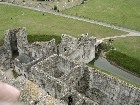 In AD. 911, the Frankish King Charles (the Simple), in an effort to reduce the raids and destruction offered a large amount of land in northern France to a band of Vikings led by Rollo in return for token obedience to the Frankish crown. During the years of "Duke" Rollo's reign, the local term for the "Norsemen" slowly contracted to "Norman" and this pretty much stuck for the rest of time.
In AD. 911, the Frankish King Charles (the Simple), in an effort to reduce the raids and destruction offered a large amount of land in northern France to a band of Vikings led by Rollo in return for token obedience to the Frankish crown. During the years of "Duke" Rollo's reign, the local term for the "Norsemen" slowly contracted to "Norman" and this pretty much stuck for the rest of time.
As befitting the descendants of excellent sea farers, the Normans traded with most of the kingdoms and Empires. They provided soldiers to act as a papal guard and not long after the conquest of the Angle's lands (England) they turned their attention to other places. The Normans raided Italy, and were a driving force behind the Crusades.
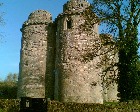 From the British point of view, the main identifiers of the Norman invaders were the language they spoke (a variant of Frankish - French) and their tendency to build castles everywhere. Prior to the Norman occupation, both the Anglo-Saxons and the Celtic Britons before them had lived in smallish communities built on hill tops. These Hill Forts were the primary means of defence and provided a community central point for refuge etc.
From the British point of view, the main identifiers of the Norman invaders were the language they spoke (a variant of Frankish - French) and their tendency to build castles everywhere. Prior to the Norman occupation, both the Anglo-Saxons and the Celtic Britons before them had lived in smallish communities built on hill tops. These Hill Forts were the primary means of defence and provided a community central point for refuge etc.


